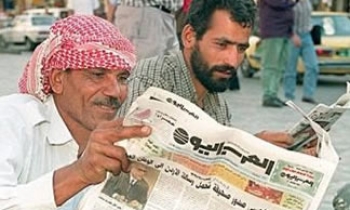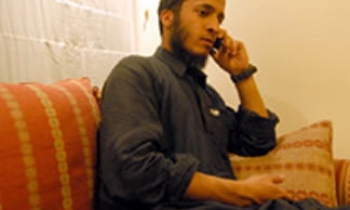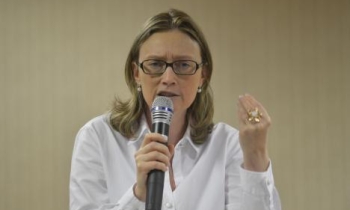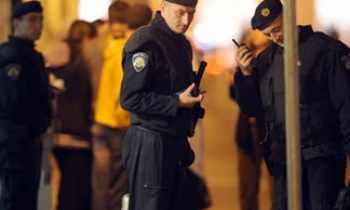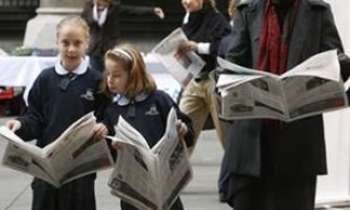LJUBLJANA, Slovenia | Political and economic pressure on the Slovenian media is on the rise. Despite many years of warnings by media experts that the state needs to abandon its indirect influence on the fourth estate, the center-right government of Janez Jansa isn’t showing any signs of breaking with the habits of its center-left predecessors. On the contrary, Slovenia’s most influential media are currently undergoing a leadership reconfiguration that many journalists see as a push to soften critical voices ahead of a series of important policy decisions and elections.
Among the most important upcoming decisions the government faces are wide-ranging economic and social reforms; the privatization of some sectors of the economy that are still heavily regulated, such as telecommunications; and the introduction of the euro in 2007. Local elections (for mayors and city councils) will take place in late 2006, presidential elections are planned for 2007, and a parliamentary election will follow in fall 2008.
Ever since gaining power in a stunning landslide victory in October 2004 that ended almost 12 years of center-left government, the Slovene Democratic Party (SDS) has made it clear it wanted to see major change in the media. The SDS accused the media of a left-wing bias, despite that its victory would not have been possible if at least some reporters and editorialists hadn’t been performing their duties properly.
This argument was rejected by SDS politicians, who pointed out that public dissatisfaction with the corruption and moral bankruptcy of the previous coalition had reached a level that change came despite the bias of the media.
A CHANGE OF THE GUARD
Less than two years after the SDS assumed power, two major newspapers and the national public broadcaster RTV Slovenija are now confronted with leadership changes that most commentators regard as a political takeover of their profession.
There are 877 media outlets in Slovenia. The most important are three daily newspapers (Delo, Dnevnik, and Vecer), a financial daily (Finance), two tabloid dailies (Slovenske novice and Direkt), three political weeklies (Mag, Mladina, Demokracija), several magazines, RTV, and a national commercial TV station (Pop TV). There are also dozens of smaller, mostly regional commercial radio and TV stations as well as smaller regional papers.
The owners of Delo and Vecer recently installed new managers, among whose tasks it was to find new managing editors. Delo, the leading broadsheet, got a new editor on 1 March, when Peter Jancic, a former editor of the domestic-politics section of Vecer, took over. Jancic has little support among staff, however: only 13 percent of Delo’s journalists voted in favor of him in a mandatory consultation. While the vote is nonbinding for the management, it does not bode well for the paper or the editor in chief.
Journalists at Delo were apparently taken aback by a passage in Jancic’s program that suggested the best way to check the professionalism of the paper’s coverage would be to ask various public officials, as well as the readership, for their opinions. A journalist at the paper who asked not to be named explained to TOL that this construed an unwelcome invitation to politicians to judge reporters’ work.
The centrist Vecer is due to get its new editor in the coming days, and changes in the paper’s editorial board are also expected.
The center-left Dnevnik, meanwhile, is experiencing a different kind of problem. Since the government does not influence the daily through a prevailing stake in its ownership (most Slovene media outlets, including the three broadsheets, were privatized in the 1990s through the internal purchase and distribution of shares), political pressure is coming through the back door of advertising. A lucrative advertising deal with the German retailer Hofer was recently scrapped. According to some media reports, the government was pressuring Hofer to stop advertising in Dnevnik if it still wanted to open new stores in Slovenia.
Government officials, the Dnevnik management, and Hofer declined to deny or confirm the reports.
The German retailer only entered the Slovenian market in 2005 and has big plans to open 20 to 30 stores across the country.
The pressure comes at a time when Dnevnik is in the middle of takeover talks with the German media giant WAZ, a company with numerous ownership stakes in Central and East European media.
A PUBLIC BROADCASTER OR A GOVERNMENT MOUTHPIECE?
Major changes are also expected at RTV Slovenija after the new government changed the public-broadcasting law last year, effectively giving politicians an even greater share in its decision-making. Afterward, a new 29-member program council was formed a body that sets the broad lines of the broadcaster’s programming policy of which 21 had to be approved by parliament. In effect, RTV’s oversight body is under the direct political control of the current governing coalition.
While it is widely acknowledged by experts and journalists that the former RTV council was flawed and open to political interference, many believe the new rules create an even worse situation. The government disregarded calls from the International Federation of Journalists and its European section as well as the Slovene Association of Journalists to reconsider the reform, though the controversial law entered into force only after a national referendum in September 2005 approved the measure with a wafer-thin majority of 50.3 percent, on a turnout of 30.7 percent.
The problems of the Slovenian national broadcaster were reflected in a report published on 1 March by the nongovernmental EU Monitoring and Advocacy Program. The report, "Television across Europe," examined the state of public-broadcasting services in 20 countries. Its author, Marko Milosavljevic, a media expert and lecturer at Ljubljana’s Faculty of Social Sciences, considers the developments at RTV Slovenija as disappointing. He wrote that the new regulations "threaten to diminish the independence and credibility of RTV Slovenija as the largest and most important broadcaster in the country."
Since Slovenia is considered a regional leader in many aspects of democratic transition, fears exist the country could serve as a bad example to others with an even higher democracy deficit. Neighboring countries could now conclude that accession to the EU would not prevent a government from reining in the media. (Slovenia entered the EU in May 2004.)
THE POLITICS OF OWNERSHIP
Nor are the current problems an isolated example of politics unduly influencing the media. In fact, such attitudes reach back to the undemocratic political system of the former Yugoslavia. As in other parts of the region, the Slovenian media were "socially owned," that is, the property of the state, political parties, or associations.
An informal political agreement existed after the demise of Yugoslavia in the early 1990s to leave the media to market forces, yet no program of systematic privatization has ever been undertaken in Slovenia.
So, after almost 15 years of independence, many media in Slovenia are still directly or indirectly owned by the state.
A recent report on the country’s media by Sandra H. Basic and Lenart J. Kucic pointed out, "Data on ownership are easily accessible but change rapidly, making the media landscape difficult to map and interpret," and that indeed seems to be among the main problems in the field.
The fact that the media don’t have long-term strategic owners opens them up to indirect government control. Delo’s largest shareholder, for example, is the Lasko brewery, which is partly owned by the state. Two other major owners of Delo are the pension fund and the capital fund, both of which are state owned.
Vecer’s largest stakeholder is the KBM INFOND investment fund, whose biggest owner is the NKBM bank, the second-largest state-owned Slovene bank. Dnevnik’s main owner is the Slovenian publishing company DZS, while the second-largest owner is the Austrian publishing company Styria Medien AG. DZS is a formerly state-owned publishing house; despite its privatization, it is considered to have close ties to the former ruling party, the Liberal Democrats.
As Basic and Kucic found out, media ownership may appear dispersed at first glance, but what it actually comes down to in practice is an intricate web among various companies, many of which are still partially owned by the state.
"The present ownership structure is the result of two factors: the absence of a distinct media policy and a special model of media privatization," the two researchers wrote. "The law that regulated the transformation of ownership of enterprises indeed enabled media employees to become major shareholders in media companies. However, these employees, whose interests the law was protecting, sold out their advantage (by selling their shares). The state, on the other hand, has directly or indirectly preserved its ownership stakes via state funds."
The politics of ownership add to a delicate situation in which the media are controlled by the owners and managers of big companies that are at the same time the largest advertisers in these media. Other influential but informal stakeholders are the owners of advertising agencies who buy and sell advertising space; the chairmen of the executive boards of Slovenia’s largest companies, which are mainly state owned; and political forces.
All of these spheres are to some extent interconnected.
According to Basic and Kucic, the question of who controls the most important dailies is not just a question of political prestige but also highlights the intricate web linking politics, business, and the media a web that has survived the privatization of Slovenia’s media.
The solution would be obvious: state-owned companies should not own stock in media enterprises. The sector needs to be privatized in practice, not just in name. But such a solution runs up against deeply entrenched interests. It is easier for each government to preserve the status quo and try to use it to its advantage. In the long term, however, this doesn’t benefit society, democracy, or journalism.
YET MORE CHANGE AHEAD
In the meantime, the government is planning more changes with a draft new media law, which would according to media experts from Ljubljana’s Faculty of Social Sciences and representatives of the Slovene journalists’ union further curb media freedom in Slovenia.
Among the most controversial measures is the right by individuals to reply in print to any article by explaining their own views or to give their account of the matter at hand. In effect, this is a massive expansion of the current right to a correction, which is limited only to factual errors.
According to Milosavljevic, the draft regulation means that media would have to publish reactions to articles that do not deal with factual errors, reactions that are based on personal views. This would open even commentaries and editorials to a "right to reply." Moreover, the proposed rule does not place limits on the length of the reply, which invites reasonable consternation.
The Ministry of Culture, the formal proponent of the draft media law, claims that the right to a reply is necessary since in the past people haven’t been given the chance to express their views in the media or have been denied the right to a correction by editors.
Journalists’ associations are already considering referring the proposal to the constitutional court if adopted in its current form, since it would, they allege, interfere with the autonomy of journalists and abuse the constitutionally granted right to a correction.
Another disputed regulation in the proposed law is the creation of a new media fund. If adopted, it will annually distribute approximately $ 5 million to media if they "will be pluralistic and adequately present positions of the government and opposition."
The parliament is expected to hold the first reading of the draft law in late March.
The news of the worsening situation of the Slovenian media has now crossed the Atlantic. The U.S. State Department’s 2005 report on the state on human rights in the world, published this month, was more critical of press freedom in Slovenia than in previous years.
The report referred to concerns of indirect government influence on the media and that many major media shareholders were partially state owned. The report further stressed that such partial government ownership resulted in self-censorship by certain media.
"In October 2005 parliament passed a law regarding national radio and television that provides increased government and parliamentary representation on the boards that directly oversee the public radio and television network. Managers reportedly protected their own economic and political interests and the interests of those in government with whom they were affiliated," the report concluded.

